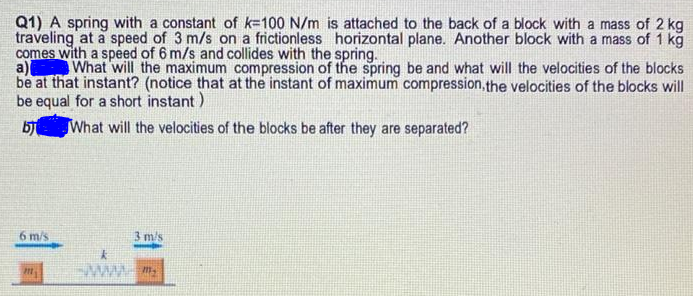Q1) A spring with a constant of k=100 N/m is attached to the back of a block with a mass of 2 kg traveling at a speed of 3 m/s on a frictionless horizontal plane. Another block with a mass of 1 kg comes with a speed of 6 m/s and collides with the spring. a) What will the maximum compression of the spring be and what will the velocities of the blocks be at that instant? (notice that at the instant of maximum compression, the velocities of the blocks will be equal for a short instant) What will the velocities of the blocks be after they are separated? bj 6 m/s 3 m/s 大 ww.
Q1) A spring with a constant of k=100 N/m is attached to the back of a block with a mass of 2 kg traveling at a speed of 3 m/s on a frictionless horizontal plane. Another block with a mass of 1 kg comes with a speed of 6 m/s and collides with the spring. a) What will the maximum compression of the spring be and what will the velocities of the blocks be at that instant? (notice that at the instant of maximum compression, the velocities of the blocks will be equal for a short instant) What will the velocities of the blocks be after they are separated? bj 6 m/s 3 m/s 大 ww.
Physics for Scientists and Engineers with Modern Physics
10th Edition
ISBN:9781337553292
Author:Raymond A. Serway, John W. Jewett
Publisher:Raymond A. Serway, John W. Jewett
Chapter9: Linear Momentum And Collisions
Section: Chapter Questions
Problem 41AP: Two gliders are set in motion on a horizontal air track. A light spring of force constant k is...
Related questions
Topic Video
Question

Transcribed Image Text:Q1) A spring with a constant of k=100 N/m is attached to the back of a block with a mass of 2 kg
traveling at a speed of 3 m/s on a frictionless horizontal plane. Another block with a mass of 1 kg
comes with a speed of 6 m/s and collides with the spring.
a)
be at that instant? (notice that at the instant of maximum compression,the velocities of the blocks will
be equal for a short instant)
What will the maximum compression of the spring be and what will the velocities of the blocks
What will the velocities of the blocks be after they are separated?
6 m/s
3 m/s
Expert Solution
This question has been solved!
Explore an expertly crafted, step-by-step solution for a thorough understanding of key concepts.
This is a popular solution!
Trending now
This is a popular solution!
Step by step
Solved in 2 steps

Knowledge Booster
Learn more about
Need a deep-dive on the concept behind this application? Look no further. Learn more about this topic, physics and related others by exploring similar questions and additional content below.Recommended textbooks for you

Physics for Scientists and Engineers with Modern …
Physics
ISBN:
9781337553292
Author:
Raymond A. Serway, John W. Jewett
Publisher:
Cengage Learning

Physics for Scientists and Engineers
Physics
ISBN:
9781337553278
Author:
Raymond A. Serway, John W. Jewett
Publisher:
Cengage Learning

University Physics Volume 1
Physics
ISBN:
9781938168277
Author:
William Moebs, Samuel J. Ling, Jeff Sanny
Publisher:
OpenStax - Rice University

Physics for Scientists and Engineers with Modern …
Physics
ISBN:
9781337553292
Author:
Raymond A. Serway, John W. Jewett
Publisher:
Cengage Learning

Physics for Scientists and Engineers
Physics
ISBN:
9781337553278
Author:
Raymond A. Serway, John W. Jewett
Publisher:
Cengage Learning

University Physics Volume 1
Physics
ISBN:
9781938168277
Author:
William Moebs, Samuel J. Ling, Jeff Sanny
Publisher:
OpenStax - Rice University

Physics for Scientists and Engineers: Foundations…
Physics
ISBN:
9781133939146
Author:
Katz, Debora M.
Publisher:
Cengage Learning

Principles of Physics: A Calculus-Based Text
Physics
ISBN:
9781133104261
Author:
Raymond A. Serway, John W. Jewett
Publisher:
Cengage Learning

Physics for Scientists and Engineers, Technology …
Physics
ISBN:
9781305116399
Author:
Raymond A. Serway, John W. Jewett
Publisher:
Cengage Learning